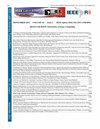Enhancing Cu2ZnSnS4 Solar Cell Efficiency through Antimony Substitution for Tin: A SCAPS-1D Simulation Study
IF 1.3
4区 工程技术
Q3 COMPUTER SCIENCE, INFORMATION SYSTEMS
引用次数: 0
Abstract
SCAPS-1D, a one-dimensional solar cell simulator, provides a valuable tool for predicting device performance based on layer-by-layer material properties. Copper Zinc Tin Sulfide (CZTS) has emerged as a promising absorber material due to its exceptional light absorption coefficient and the abundance and non-toxic nature of its constituent elements. This study leverages SCAPS-1D to investigate the working mechanism of CZTS-based solar cells. We simulate a Mo/CZTS/CdS/ZnO device structure under AM 1.5 spectrum illumination and 300 K temperature, analyzing the impact of individual layer thickness on photovoltaic performance. Further, a comparative analysis explores the influence of various n-type materials.. In addition, the introduction of antimony (Sb) doping into CZTS leads to a significant change in efficiency of the cell. The efficiency of Sbdoping CZTS attained 21.90%, while there was a great improvement by 3% via reduced recombination losses and enhanced photocurrent. This work gives an insight into the possibility of Sb doping for the improvement in the performance of thin-film solar cells.用锑取代锡提高Cu2ZnSnS4太阳能电池效率:SCAPS-1D模拟研究
SCAPS-1D 是一种一维太阳能电池模拟器,是根据逐层材料特性预测设备性能的重要工具。铜锌锡硫化物(CZTS)因其优异的光吸收系数及其组成元素的丰富性和无毒性,已成为一种前景广阔的吸收材料。本研究利用 SCAPS-1D 来研究基于 CZTS 的太阳能电池的工作机制。我们模拟了 AM 1.5 光谱照明和 300 K 温度条件下的 Mo/CZTS/CdS/ZnO 器件结构,分析了单层厚度对光伏性能的影响。此外,对比分析还探讨了各种 n 型材料的影响。此外,在 CZTS 中掺入锑(Sb)会显著提高电池的效率。掺锑 CZTS 的效率达到了 21.90%,而通过减少重组损耗和增强光电流,效率提高了 3%。这项研究深入探讨了掺杂锑以提高薄膜太阳能电池性能的可能性。
本文章由计算机程序翻译,如有差异,请以英文原文为准。
求助全文
约1分钟内获得全文
求助全文
来源期刊

IEEE Latin America Transactions
COMPUTER SCIENCE, INFORMATION SYSTEMS-ENGINEERING, ELECTRICAL & ELECTRONIC
CiteScore
3.50
自引率
7.70%
发文量
192
审稿时长
3-8 weeks
期刊介绍:
IEEE Latin America Transactions (IEEE LATAM) is an interdisciplinary journal focused on the dissemination of original and quality research papers / review articles in Spanish and Portuguese of emerging topics in three main areas: Computing, Electric Energy and Electronics. Some of the sub-areas of the journal are, but not limited to: Automatic control, communications, instrumentation, artificial intelligence, power and industrial electronics, fault diagnosis and detection, transportation electrification, internet of things, electrical machines, circuits and systems, biomedicine and biomedical / haptic applications, secure communications, robotics, sensors and actuators, computer networks, smart grids, among others.
 求助内容:
求助内容: 应助结果提醒方式:
应助结果提醒方式:


